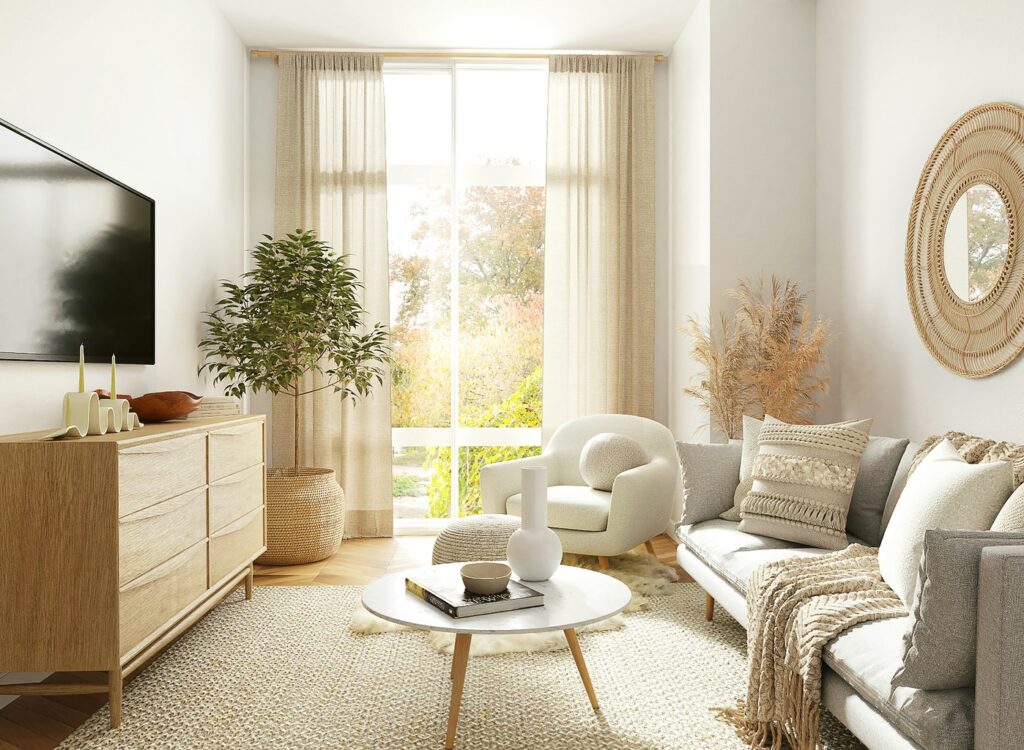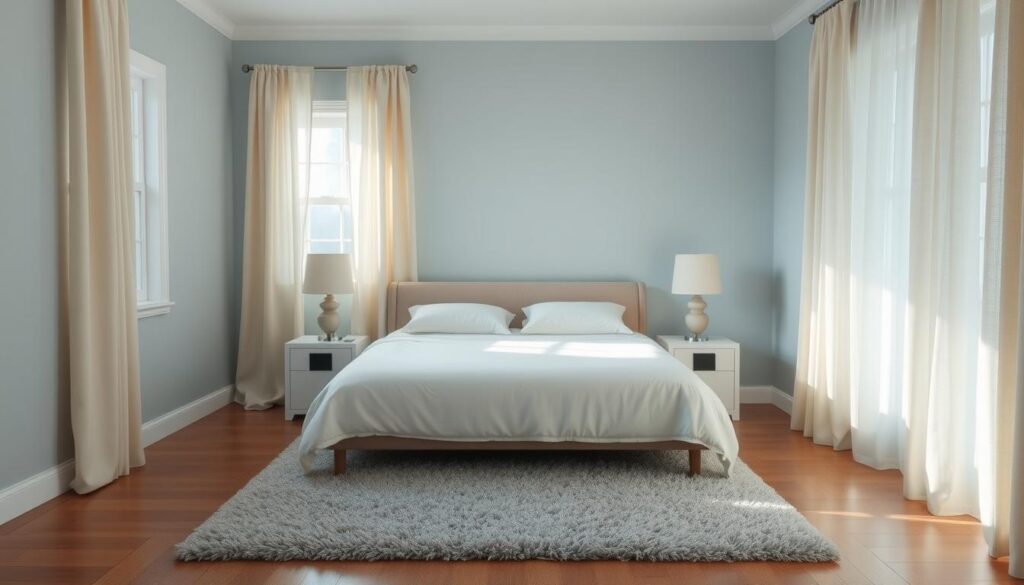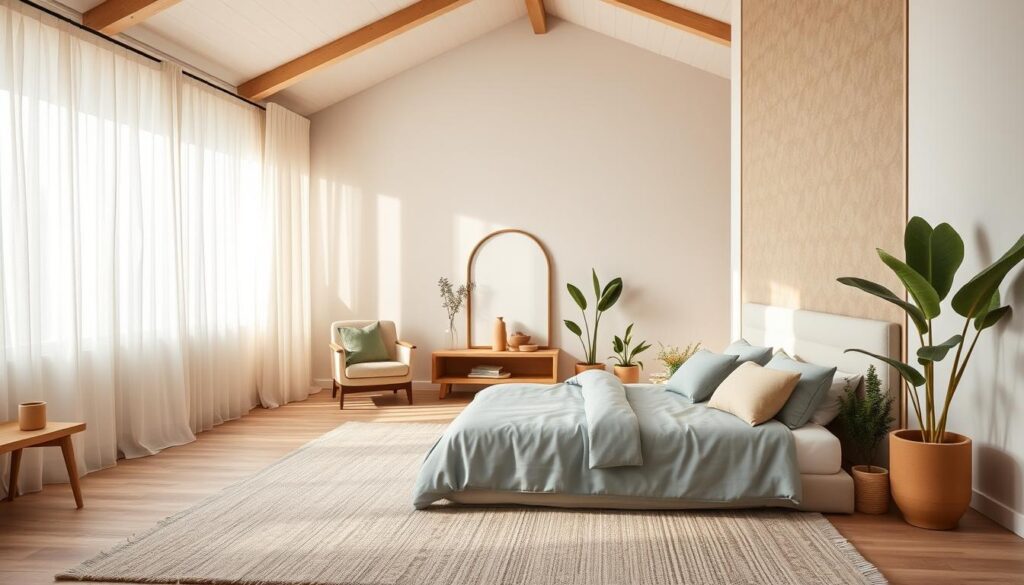
Are you tired of tossing and turning at night, struggling to get a good night’s sleep? The colors surrounding you in your bedroom may be the culprit. Research suggests that certain calming bedroom colors can significantly impact our mood and sleep quality, making it essential to select colors that promote relaxation.
Choosing the right colors for your bedroom can be a game-changer for a restful and rejuvenating sleep experience. In this article, we’ll explore the top colors that can create a serene atmosphere, perfect for unwinding after a long day.
Key Takeaways
- Discover the most effective calming colors for a restful sleep
- Learn how different colors impact your mood and sleep quality
- Explore the top colors that promote relaxation in the bedroom
- Understand the importance of selecting the right colors for your bedroom
- Create a serene atmosphere that fosters a good night’s sleep
The Science of Color and Sleep Quality
The impact of color on our sleep is a complex interplay of psychological and physiological factors. The colors we surround ourselves with in the bedroom can significantly influence our mood, relaxation, and overall sleep quality.
How Colors Affect Your Mood and Sleep Patterns
Colors can affect our emotions and mood, with different hues triggering various psychological responses. For instance, cool colors like blue and green are often associated with feelings of calmness and relaxation, while warm colors like red and orange can stimulate alertness and energy.
The Psychological Impact of Bedroom Colors
The psychological impact of bedroom colors cannot be overstated. Soothing bedroom hues can create a peaceful atmosphere, conducive to relaxation and sleep. On the other hand, jarring or bright colors can disrupt sleep patterns and make it difficult to fall asleep.
Research-Backed Color Benefits
Research has identified certain colors that have a positive impact on sleep quality. For example, soft blues and pale greens are among the popular bedroom paint shades that can promote relaxation and improve sleep. Understanding the science behind these colors can help individuals make informed decisions when choosing their bedroom colors.
By selecting the right colors for our bedrooms, we can create a sleep-conducive environment that enhances the quality of our rest.
What Makes a Color Relaxing?

Understanding what makes a color relaxing is crucial for designing a bedroom that promotes restful sleep. The psychology behind color perception plays a significant role in how we respond to different hues.
Color Psychology Basics
Color psychology is the study of how colors affect human behavior and emotions. In the context of a bedroom, the goal is to choose colors that promote relaxation and reduce stress. Serene room colors are typically those that have a calming effect on the mind and body.
Warm vs. Cool Colors for Relaxation
Colors are generally categorized into warm and cool colors. Warm colors, such as oranges and reds, tend to energize and stimulate, while cool colors, like blues and greens, are more calming. For a relaxing bedroom, cool colors are often preferred as they promote a sense of tranquility.
- Cool colors like blue and green can lower blood pressure and heart rate.
- Warm colors can be used as accent colors to add coziness without being overwhelming.
Saturation and Intensity Considerations
The saturation and intensity of a color also play a crucial role in its relaxing effect. Highly saturated colors can be overwhelming, while desaturated colors tend to be more calming. For the best colors for relaxing bedrooms, it’s often recommended to use softer, less intense shades.
Some key considerations include:
- Choosing colors with lower saturation levels.
- Avoiding overly bright or neon colors.
- Using pastel shades or muted tones for a calming effect.
Colors to Avoid in Relaxation Spaces
Certain colors can significantly impact our ability to relax and sleep, making it essential to avoid them in bedroom design. While personal preferences play a role, some colors are generally considered less suitable for promoting a restful environment.
Why Bright Red Disrupts Sleep
Bright red is a highly stimulating color that can increase heart rate and alertness, making it difficult to wind down and fall asleep. It’s a color often associated with energy and excitement, which is counterproductive in a bedroom setting.
The Problem with Pure White Walls
Pure white walls can create a harsh, clinical environment that lacks warmth and coziness. While white is often used to make spaces feel larger, an all-white bedroom can feel sterile and uninviting, potentially causing visual discomfort.
When Yellow Becomes Overwhelming
While soft, muted yellows can be cheerful, bright and saturated yellows can be overwhelming, potentially causing eye strain and discomfort. In a bedroom, it’s best to opt for softer, more muted shades if you wish to incorporate yellow into your decor.
| Color | Effect on Sleep | Recommended Alternative |
|---|---|---|
| Bright Red | Stimulates, increases heart rate | Soft Blues or Greens |
| Pure White | Can feel harsh, clinical | Soft Creams or Beiges |
| Bright Yellow | Can be overwhelming | Muted, Soft Yellows |
By avoiding these potentially disruptive colors and opting for more soothing alternatives, you can create a bedroom environment that promotes relaxation and improves sleep quality.
Top5 Bedroom Colors for Ultimate Relaxation

The colors you choose for your bedroom can significantly impact your ability to relax and unwind. A calming color scheme can help reduce stress and promote better sleep.
Selection Criteria for Our Top Picks
Our selection of the top 5 bedroom colors is based on research into color psychology, sleep quality, and relaxation techniques. We considered factors such as the emotional impact of different colors, their ability to reduce stress, and their overall aesthetic appeal.
How These Colors Work in Different Spaces
The effectiveness of these colors can vary depending on the specific design elements of your bedroom, such as furniture, decor, and natural lighting. Here’s a breakdown of how our top colors perform in different settings:
| Color | Small Bedroom | Large Bedroom |
|---|---|---|
| Soft Blue | Makes the room feel larger | Creates a cozy atmosphere |
| Gentle Lavender | Adds a touch of elegance | Promotes relaxation |
| Soft Green | Bringing in a natural feel | Enhances the sense of calm |
| Warm Neutrals | Makes the space feel cozier | Provides a clean backdrop |
| Pale Pink | Adds a soft, romantic touch | Creates a sophisticated ambiance |
1. Soft Blue: The Ultimate Sleep Enhancer
Soft blue hues have long been revered for their calming effects, making them an ideal choice for bedrooms. The soothing quality of soft blue can significantly enhance sleep quality by creating a serene atmosphere.
Why Blue Promotes Relaxation and Lowers Blood Pressure
Blue is often associated with feelings of tranquility and calmness. Research has shown that exposure to blue can lower blood pressure and heart rate, contributing to a restful night’s sleep. The psychological impact of blue is such that it can reduce stress and anxiety, making it easier to fall asleep.
Key benefits of soft blue bedrooms include:
- Enhanced relaxation
- Improved sleep quality
- Reduced stress and anxiety
Best Blue Shades for Bedrooms: Powder, Sky, and Periwinkle
When it comes to choosing the right shade of blue, there are several options to consider. Powder blue offers a soft, gentle hue that can add a touch of elegance to any bedroom. Sky blue brings a sense of openness and airiness, while periwinkle adds a subtle pop of color without being overwhelming.
Complementary Colors and Accent Recommendations
To create a harmonious bedroom environment, it’s essential to balance soft blue walls with complementary colors and accents. Neutral tones like white, beige, or gray can provide a clean contrast to soft blue.
Furniture Pairings for Blue Bedrooms
When selecting furniture for a soft blue bedroom, consider pieces with clean lines and minimal ornamentation. White or light wood furniture can complement soft blue walls beautifully.
Lighting Considerations for Blue Spaces
Lighting can significantly impact the ambiance of a soft blue bedroom. Warm lighting can create a cozy atmosphere, while cool lighting can enhance the calming effects of the blue hue.
By incorporating soft blue into your bedroom design, you can create a serene and relaxing space that promotes better sleep and overall well-being.
2. Gentle Lavender: Calming Without Being Too Feminine
Gentle lavender hues can create a soothing ambiance in bedrooms, promoting relaxation. This calming color has been associated with reduced stress levels and improved sleep quality.
The Soothing Properties of Lavender for Stress Reduction
Lavender is renowned for its stress-reducing properties. Studies have shown that exposure to lavender can lower cortisol levels, heart rate, and blood pressure, creating a peaceful environment conducive to sleep.
The calming effects of lavender make it an ideal choice for bedrooms. By incorporating this soothing color into your bedroom design, you can promote relaxation and improve the quality of your sleep.
Modern Ways to Use Lavender in Contemporary Bedrooms
In contemporary bedroom design, lavender can be used in various ways to create a calming atmosphere. From lavender-painted walls to lavender-accented bedding and decor, there are numerous options to suit different tastes and styles.
- Lavender paint shades can range from soft pastel tones to deeper, richer hues, offering versatility in design.
- Lavender can be paired with a variety of colors to create a unique and personalized bedroom atmosphere.
Creating Balance with Lavender and Neutrals
To avoid an overly feminine look, it’s essential to balance lavender with neutral tones. This balance creates a harmonious and calming environment.
Neutrals That Complement Lavender: Grays and Taupes
Grays and taupes are excellent neutral choices that complement lavender beautifully. These colors help to ground the space and prevent it from feeling too sweet or overly feminine.
For example, pairing soft lavender walls with gray bedding and taupe accents can create a sophisticated and calming bedroom atmosphere.
Texture and Pattern Considerations for Depth
To add depth to a lavender-themed bedroom, consider incorporating various textures and patterns. Mixing different textures, such as smooth linens, plush rugs, and rough-hewn wood furniture, can create a visually interesting space.
Patterns, like subtle botanical prints or geometric designs, can also be used to add depth and visual interest to the room.
3. Soft Green: Bringing Nature's Tranquility Indoors
Green is known for its restorative properties, and using soft green in bedrooms can promote mental restoration and relaxation. This calming color brings the tranquility of nature indoors, making it an ideal choice for those seeking best colors for relaxing bedrooms.
The Restorative Power of Green for Mental Fatigue
Soft green is particularly effective at reducing mental fatigue. The human eye is most comfortable with colors in the green spectrum, as they are easiest to perceive and process. This reduces visual strain and promotes a sense of calm, making soft green one of the top tranquil paint colors for sleeping spaces.
From Sage to Mint: Choosing the Right Green Undertones
When selecting a soft green for your bedroom, consider the undertones. Sage green, with its muted, grayish undertones, can add a sophisticated touch. Mint green, on the other hand, brings a fresh, calming feel. The right undertone can enhance the relaxing ambiance of your bedroom.
Biophilic Design Principles with Green Walls
Biophilic design emphasizes the connection between nature and built environments. Using soft green walls is a key aspect of this design philosophy, as it brings the outdoors in. This approach not only enhances the aesthetic appeal of your bedroom but also contributes to a restful atmosphere.
Plant Pairings That Enhance Green Bedrooms
To further enhance the natural ambiance, consider pairing soft green walls with plants. Some excellent choices include:
- Snake plants for their low-maintenance and air-purifying qualities
- Pothos for its trailing vines and adaptability to various lighting conditions
- Peace lilies for their elegant white blooms and ability to purify the air
Natural Material Combinations for Authenticity
Combining soft green walls with natural materials can amplify the biophilic effect. Consider incorporating:
- Reclaimed wood furniture for a rustic, earthy feel
- Stone or marble accents to add texture and visual interest
- Woven fibers like wicker or rattan for a cozy, organic touch
By thoughtfully integrating soft green into your bedroom design, along with complementary elements, you can create a serene and restorative environment that embodies the best colors for relaxing bedrooms.
4. Warm Neutrals: Timeless Comfort
Warm neutrals bring a sense of enduring comfort and tranquility to any bedroom, making them an ideal choice for those seeking serene room colors. These soothing hues create a cozy retreat that invites relaxation and rest.
The Versatility of Beiges, Taupes, and Greiges
Beiges, taupes, and greiges are more than just neutral colors; they’re a canvas for your bedroom’s personality. Each of these warm neutrals offers a unique backdrop for decor, from modern minimalism to traditional elegance. For instance, beiges can range from soft cream to warm caramel, offering a variety of shades to suit different tastes.
| Color | Description | Ideal For |
|---|---|---|
| Beige | Soft, neutral tone | Minimalist decor |
| Taupes | Warm, earthy shade | Traditional or rustic themes |
| Greiges | Blend of gray and beige | Modern, sophisticated interiors |
Creating Warmth Without Visual Overstimulation
The key to using warm neutrals effectively is to create warmth without overwhelming the senses. This can be achieved by balancing your chosen neutral with thoughtful decor choices and layering different textures to add depth.
“The right color can transform a room, making it feel cozy and inviting. Warm neutrals are particularly effective at creating a soothing atmosphere.”
Layering Neutrals for Dimension and Depth
Layering different shades of neutrals can add dimension to your bedroom. Start with a base color on the walls, then incorporate different shades through furniture and decor.
Texture as the Key Element in Neutral Bedrooms
Texture plays a crucial role in neutral bedrooms, adding visual interest and tactile experience. Mix smooth surfaces with rougher textures to create a balanced look.
Accent Colors That Enhance Neutral Foundations
While neutrals form the base, accent colors can add personality to your bedroom. Choose colors that complement your neutral palette, such as soft blues or rich greens, to create a harmonious and soothing bedroom hue.
By incorporating warm neutrals and balancing them with texture and accent colors, you can create a bedroom that is both serene and inviting.
5. Pale Pink: The New Neutral
In the realm of bedroom decor, pale pink is gaining traction as a calming neutral shade. This soft, gentle hue is not only aesthetically pleasing but also offers a serene ambiance that promotes relaxation.
Beyond Gender Stereotypes: Modern Blush Tones
Pale pink has often been associated with traditional feminine decor, but modern blush tones have evolved beyond these stereotypes. Today, pale pink is recognized as a versatile and sophisticated color choice that can complement a wide range of bedroom styles.
Modern Design Approaches: By incorporating pale pink into a bedroom design, individuals can create a calming and elegant atmosphere that is both soothing and visually appealing.
The Surprising Calming Effects of Pink on Nervous System
Research has shown that the color pink can have a calming effect on the nervous system, reducing stress and anxiety. Pale pink, in particular, offers a softer and more subtle alternative to brighter pinks, creating a peaceful environment conducive to rest.
Sophisticated Pink Bedroom Design Approaches
To create a sophisticated pale pink bedroom, consider balancing the softness of the color with deeper accents and elegant metallics. This can be achieved through various design elements, such as furniture, bedding, and decorative accessories.
Grounding Pink with Deeper Accents and Charcoals
Pairing pale pink walls with charcoal grey or navy blue accents can add depth and contrast to the bedroom, preventing the space from feeling too sweet or overly feminine. This combination creates a harmonious balance between softness and sophistication.
Metallics and Pink: Creating Elegant Combinations
Incorporating metallic elements, such as rose gold or brass, with pale pink can elevate the bedroom’s elegance. These metallic accents can be introduced through lighting fixtures, hardware, or decorative accessories, adding a touch of luxury to the space.
By embracing pale pink as a neutral shade in bedroom design, individuals can create a calming, sophisticated, and uniquely personal space that promotes relaxation and serenity.
Practical Implementation Tips for Relaxing Bedroom Colors
Creating a relaxing bedroom environment involves more than just choosing the right colors; it’s about implementing them effectively. The right implementation can enhance the calming effects of the colors you’ve chosen for your bedroom.
The 60-30-10 Color Rule for Balanced Bedrooms
A balanced color scheme is crucial for a relaxing bedroom. The 60-30-10 rule is a simple yet effective way to achieve this balance. Allocate 60% of the room to a dominant color, 30% to a secondary color, and 10% to an accent color. This distribution creates harmony and visual interest.
Testing Colors Before Committing: Sample Strategies
Before painting the entire bedroom, test the colors. Here are some strategies:
- Paint small swatches on the walls.
- Use colored cards or paper to gauge the color’s effect.
- Observe how the color looks at different times of day.
Working with Existing Furniture and Decor Elements
When working with existing furniture, choose colors that complement the pieces. For example, if you have a bold-colored dresser, balance it with neutral walls. Consider the color of your bedding, curtains, and other decor to ensure they work together harmoniously.
| Furniture/Decor | Color | Complementary Wall Color |
|---|---|---|
| Dark Wood Furniture | Brown | Soft Blue or Pale Green |
| Bold-colored Dresser | Red | Neutral Beige or Cream |
Seasonal Adjustments with Textiles and Accessories
To maintain a calming atmosphere year-round, make seasonal adjustments using textiles and accessories. For instance, switch to lighter fabrics in summer and cozier throws in winter. This approach allows you to refresh your bedroom’s look without repainting.
By implementing these practical tips, you can create a bedroom that is not only visually appealing but also a tranquil retreat that promotes relaxation and better sleep.
Conclusion
Choosing the right colors for your bedroom is crucial for a restful sleep experience. Our exploration of the top5 bedroom colors for ultimate relaxation has highlighted the importance of serene room colors in creating a calming atmosphere.
Soft blue, gentle lavender, soft green, warm neutrals, and pale pink are the top colors that can transform your bedroom into a relaxing retreat. These colors have been shown to promote relaxation, reduce stress, and improve sleep quality.
When implementing these colors, consider the 60-30-10 color rule, test samples before committing, and work with existing furniture and decor elements. By doing so, you can create a harmonious and calming bedroom environment that fosters ultimate relaxation.
Experiment with these top5 bedroom colors and discover the perfect combination to enhance your sleep and overall well-being. With the right colors, you can turn your bedroom into a serene sanctuary that rejuvenates both body and mind.
FAQ
What are the best bedroom colors for relaxation?
The top colors for relaxation are soft blue, gentle lavender, soft green, warm neutrals, and pale pink, as they promote a calming atmosphere and improve sleep quality.
How do I choose the right shade of blue for my bedroom?
Consider powder blue, sky blue, or periwinkle shades, which are known to promote relaxation and lower blood pressure. You can also test samples on your walls before committing to a specific shade.
Can I use lavender in a masculine bedroom design?
Yes, you can incorporate lavender into a masculine bedroom by balancing it with neutral tones like grays and taupes, and adding texture and pattern to create depth.
What are the benefits of using soft green in the bedroom?
Soft green brings the tranquility of nature indoors, promoting mental restoration and relaxation. It’s also a versatile color that can be paired with various natural materials and plants.
How can I add warmth to a neutral-colored bedroom?
You can create warmth in a neutral bedroom by layering different textures, using warm-toned accents, and incorporating natural materials like wood and woven fibers.
Is pale pink a suitable color for a bedroom?
Yes, pale pink is a calming and sophisticated color that can create a relaxing atmosphere in the bedroom. It can be paired with deeper accents and metallics to add elegance.
What is the 60-30-10 color rule, and how can I apply it to my bedroom?
The 60-30-10 color rule involves dividing your bedroom color palette into 60% dominant color, 30% secondary color, and 10% accent color. This helps create a balanced and harmonious color scheme.
How can I test bedroom colors before painting the walls?
You can test colors by painting samples on the walls, using online color picker tools, or applying paint swatches to your walls to see how the color looks at different times of day.
Can I use these relaxing colors in a small bedroom?
Yes, these colors can be used in small bedrooms. Soft colors like pale pink, soft blue, and gentle lavender can make a small room feel more spacious and calming.




